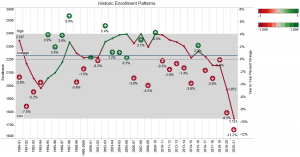
For the past five years, enrollment numbers at DePauw University have been consistently decreasing. Currently, there are 513 students less than 2015, with the most alarming decreases occurring in the last two years.
Overall, DePauw’s total enrollment every fall semester has decreased by 23 percent between 2015 and 2020. For the past five years, the number of applications has ranged from approximately 4,900 to 5,600. Last year, in an effort to increase enrollment, DePauw’s admissions office increased the number of admitted students to the highest it has been in the past 5 years, admitting nearly 3,800 students.
The steep decline in enrollment is not exclusive to DePauw. Across the United States, small, rural liberal arts colleges are experiencing similar challenges to maintain sufficient enrollment numbers. This trend can be correlated to issues including but not limited to rising tuition costs, concerns about student debt, and a shrinking population of young people.
To fight this downward trend, the office of admissions is implementing a number of changes in outreach tactics. The strategic planning committee is working with faculty, staff, students, and alumni to bring the enrollment numbers back to what they were 3-5 years ago. In addition to this, the admissions office is doubling down to build DePauw’s brand in its main markets in the midwest.
”National enrollment challenges are real and it will take the help of the entire campus community,” Amanda Ryan, Assistant Vice President of Admissions, said.
Between the 2019-2020 school year and the 2020-2021 school year, there has been an 11 percent decrease in total enrollment from 1,972 students to 1,752 students.
According to Terry Cowdry, Vice President of Admissions, each year their office collects data from students who are admitted but decide to enroll elsewhere. Although they do not get a response from many students, the four main categories of reasons that students choose elsewhere are cost/financial aid (36 percent), larger school/athletics (20 percent), academic programs (19 percent), and proximity to home (11 percent).

Cowdry mentioned that in Fall 2020, the retention rate among students’ first-year to second-year retention was 89 percent compared to 86 percent last year for students who started in the Fall of 2018. With the exception of last year, it has ranged from 88 percent to 94 percent each year for the past 10 years.
Cowdrey said that everyone, from the admissions staff to the faculty and coaches and current students, is still actively engaged in promoting the benefits of DePauw to prospective students. At the time of this interview in early November, 400 students have already been offered admission. Cowdrey believes giving more prospective students extra time to decide will strengthen the chances that they attend DePauw.
In a meeting, President Lori White conveyed that she is optimistic about enrollment at DePauw. White conveyed that before long, after this pandemic has passed, DePauw will return to being one of the best liberal arts universities in the midwest, despite the recent challenges the university has faced over the past few years regarding enrollment numbers.


